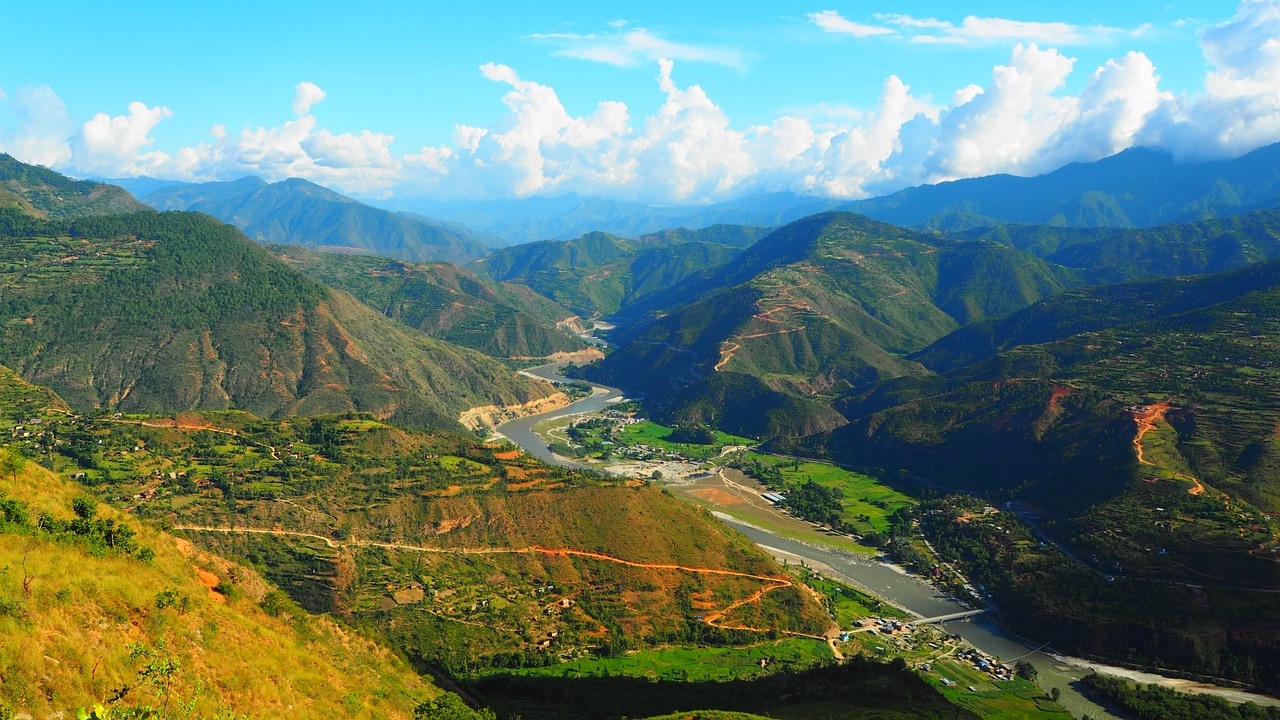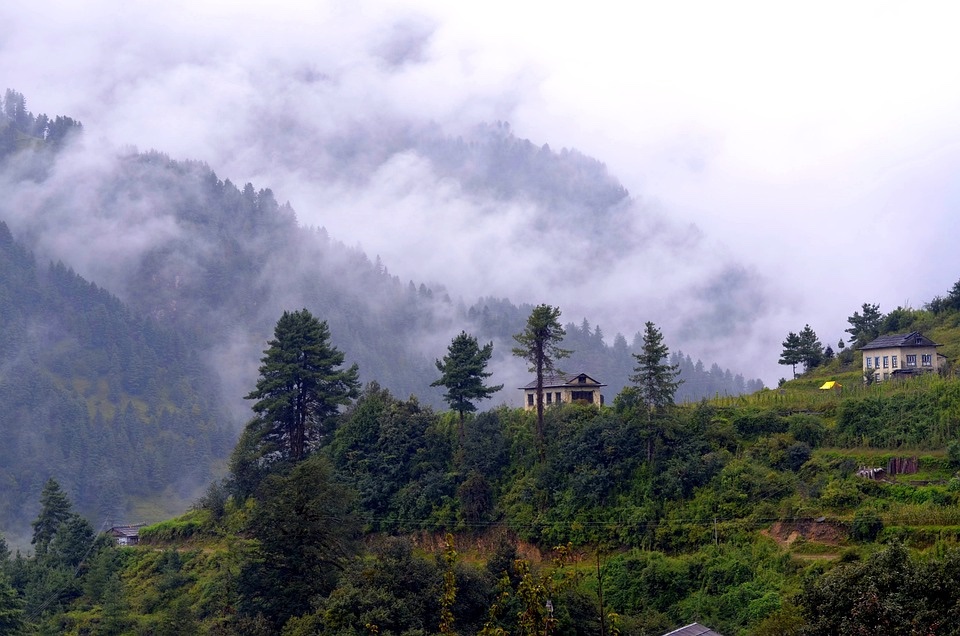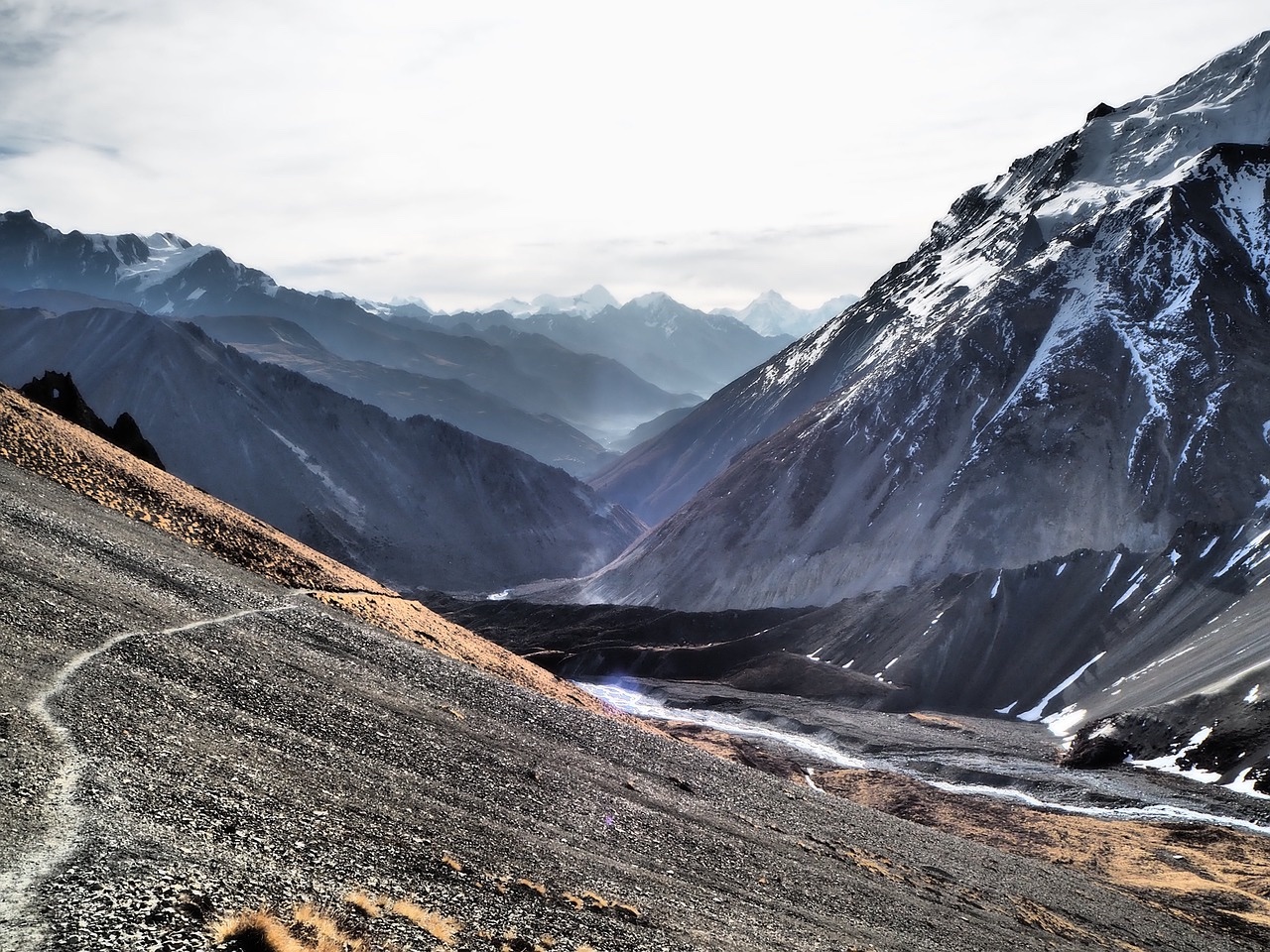TRAVEL
Why Trek in Nepal?

Nepal is not just about conquering peaks. It’s an ideal destination for those who appreciate the beauty of nature in its purest form. The country’s varied landscapes, from subtropical forests to alpine meadows, host an impressive range of wildlife, including some rare and endangered species. Trekking in Nepal offers the chance to witness this biodiversity up close, with the backdrop of some of the world’s most stunning natural scenery.
Nepal’s well-preserved national parks and conservation areas, alongside its cultural richness and warm hospitality, make it a dream destination for trekkers who wish to blend adventure with wildlife observation.
1. Annapurna Circuit Trek
The Annapurna Circuit is one of Nepal’s most iconic treks, renowned for its breathtaking scenery and diverse wildlife. This trek circles the majestic Annapurna Massif, taking you through lush forests, traditional villages, and high-altitude deserts.
Wildlife Highlights
- Red Panda: The lush rhododendron forests are home to the elusive red panda. Keep your eyes peeled for this adorable creature as you trek through the lower regions.
- Himalayan Tahr: A large herbivore resembling a wild goat, often seen grazing on the high slopes.
- Blue Sheep (Bharal): Look out for these agile creatures on rocky cliffs and ridges.
Key Facts
- Duration: 15-20 days
- Difficulty: Moderate to Challenging
- Best Time to Trek: October to November and March to April
- Permits Required: Annapurna Conservation Area Permit (ACAP) and Trekkers’ Information Management System (TIMS) card
2. Langtang Valley Trek
Just north of Kathmandu lies the Langtang Valley, a region rich in biodiversity and culture. Often referred to as the “Valley of Glaciers,” this trek offers a more relaxed pace and a chance to immerse yourself in the natural beauty and tranquility of the Himalayas.
Wildlife Highlights
- Red Panda: Again, the lush forests of Langtang are prime habitats for red pandas.
- Langur Monkeys: These playful primates can be seen swinging from tree to tree.
- Himalayan Black Bear: Rare sightings of this formidable creature can be experienced, but caution is advised.
Key Facts
- Duration: 7-10 days
- Difficulty: Moderate
- Best Time to Trek: September to December and March to May
- Permits Required: Langtang National Park Permit and TIMS card

3. Kanchenjunga Base Camp Trek
Overview
The Kanchenjunga Base Camp Trek offers an unparalleled experience for those seeking solitude and pristine wilderness. As you trek towards the world’s third-highest mountain, you’ll pass through remote villages and dense forests teeming with wildlife.
Wildlife Highlights
- Snow Leopard: This elusive predator prowls the high altitudes; sightings are rare but possible.
- Himalayan Musk Deer: An endangered species known for its musk glands, which are often targeted by poachers.
- Impeyan Pheasant (Danphe): Nepal’s national bird, recognizable by its vibrant plumage.
Key Facts
- Duration: 20-24 days
- Difficulty: Challenging
- Best Time to Trek: Late March to May and October to November
- Permits Required: Kanchenjunga Conservation Area Permit and TIMS card

4. Manaslu Circuit Trek
A hidden gem, the Manaslu Circuit Trek offers an off-the-beaten-path experience with fewer trekkers and a more authentic connection with nature. It encircles Mount Manaslu, the eighth-highest peak in the world.
Wildlife Highlights
- Asiatic Black Bear: Keep an eye out for these bears as you move through forested areas.
- Pika: A small mammal related to rabbits, often spotted scurrying among the rocks.
- Golden Eagle: These majestic birds of prey can be seen soaring high above the valleys.
Key Facts
- Duration: 14-18 days
- Difficulty: Moderate to Challenging
- Best Time to Trek: September to November and March to May
- Permits Required: Manaslu Restricted Area Permit, Manaslu Conservation Area Permit, and TIMS card
5. Everest Base Camp Trek
The Everest Base Camp Trek is undoubtedly the most famous trek in the world. While its main draw is the allure of the highest peak, it also offers a rich diversity of wildlife and cultural experiences in the Khumbu region.
Wildlife Highlights
- Snow Leopard: Though sightings are rare, the high-altitude areas are home to this elusive big cat.
- Himalayan Monal: Another striking bird with iridescent feathers, often seen near tree lines.
- Himalayan Thar: You might spot these animals on the rocky slopes around Namche Bazaar and above.
Key Facts
- Duration: 12-16 days
- Difficulty: Moderate
- Best Time to Trek: March to May and September to November
- Permits Required: Sagarmatha National Park Permit and TIMS card
6. Makalu Base Camp Trek
This trek is a journey into one of the most isolated and unspoiled regions of Nepal, offering a remarkable experience for adventure seekers and wildlife enthusiasts alike. The trek to the base of the world’s fifth-highest mountain is demanding but rewarding.
Wildlife Highlights
- Snow Leopard: This trek offers a greater chance of spotting this elusive predator.
- Red Panda: The dense forests at lower altitudes harbor this charming creature.
- Himalayan Marmot: These large ground squirrels are often seen sunbathing on the rocks.
Key Facts
- Duration: 18-22 days
- Difficulty: Challenging
- Best Time to Trek: Late March to May and September to November
- Permits Required: Makalu Barun National Park Permit and TIMS card
7. Upper Mustang Trek
The Upper Mustang Trek is a journey into a unique and isolated region known as the “Forbidden Kingdom.” This trek offers not just wildlife but also a cultural exploration of Tibetan-influenced traditions and landscapes.
Wildlife Highlights
- Snow Leopard: This region is part of a snow leopard conservation area, increasing chances of sightings.
- Wild Ass (Kiang): These magnificent creatures roam the high-altitude plateaus.
- Tibetan Wolf: Occasionally sighted in the more remote areas.
Key Facts
- Duration: 12-15 days
- Difficulty: Moderate
- Best Time to Trek: March to November
- Permits Required: Annapurna Conservation Area Permit and a special Mustang Restricted Area Permit
8. Rara Lake Trek
Rara Lake, the largest lake in Nepal, is nestled within Rara National Park, a region less frequented by tourists but rich in natural beauty and biodiversity. This trek offers an opportunity to experience Nepal’s wild and remote landscapes.
Wildlife Highlights
- Red Panda: The surrounding forests provide habitat for this endearing species.
- Himalayan Black Bear: The park is home to a significant population of these bears.
- Barking Deer: Known for its distinct alarm call, it is often spotted in the forests around Rara Lake.
Key Facts
- Duration: 10-12 days
- Difficulty: Moderate
- Best Time to Trek: September to November and April to May
- Permits Required: Rara National Park Permit and TIMS card
Essential Trekking Tips for Wildlife Enthusiasts
Trekking in Nepal offers incredible wildlife viewing opportunities, but it’s important to do so responsibly. Here are some tips to enhance your experience:
- Respect Wildlife: Always maintain a safe distance from animals and never attempt to feed them.
- Leave No Trace: Follow the principles of “Leave No Trace” to minimize your environmental impact.
- Use a Local Guide: Hiring a knowledgeable local guide can significantly enhance your trekking experience and increase your chances of spotting wildlife.
- Be Prepared for Altitude: Acclimatization is crucial when trekking at high altitudes. Allow time to adjust and recognize the signs of altitude sickness.
- Pack Wisely: Bring binoculars, a camera, and appropriate clothing to adapt to varying climates.
- Stay Informed: Understand the specific regulations of the areas you plan to visit, including any wildlife protection rules.
FAQs
1. What is the best time to trek in Nepal for wildlife viewing?
The best time for trekking in Nepal and wildlife observation is typically from September to November and March to May. During these months, the weather is more stable, and wildlife is more active.
2. Are permits necessary for trekking in Nepal?
Yes, most treks require permits. Common permits include the Annapurna Conservation Area Permit (ACAP), Langtang National Park Permit, TIMS card, and special area permits for restricted regions.
3. How physically challenging are these treks?
The treks range from moderate to challenging, depending on the route and duration. Physical fitness and proper acclimatization are crucial for a safe and enjoyable trekking experience.
4. What wildlife can I expect to see in Nepal?
Nepal is home to a wide variety of wildlife, including the red panda, snow leopard, Himalayan tahr, Himalayan black bear, and numerous bird species like the Impeyan pheasant.
5. Is it safe to trek alone in Nepal?
While trekking alone is possible, it is recommended to trek with a group or hire a guide for safety, especially in more remote and challenging region.
Final Thoughts
Nepal is a paradise for wildlife enthusiasts, offering an unparalleled blend of adventure and natural beauty. Whether you’re trekking through the lush forests of Langtang or exploring the remote valleys of Upper Mustang, each trek presents a unique opportunity to witness Nepal’s diverse ecosystems and wildlife.
With careful planning and respect for nature, you can embark on a journey that not only challenges you physically but also enriches your appreciation for the natural world. So pack your bags, lace up your boots, and set out on an unforgettable adventure in Nepal!
TRAVEL
Cheapest Business Class Flights: How to Fly Luxe for Less

Who doesn’t dream of reclining in a lie-flat seat, savoring gourmet meals, and bypassing long queues—all without breaking the bank? Finding the cheapest business class flights is possible with the right strategies. Whether you’re a frequent flyer or planning a once-in-a-lifetime trip, this guide reveals insider tips to secure affordable luxury in the skies.
Why Business Class Is Worth the Splurge
Flying business class isn’t just about comfort—it’s a game-changer for long-haul travel. With priority boarding, extra baggage allowances, and premium lounges, the experience justifies the cost. However, paying full price isn’t your only option. By leveraging timing, loyalty programs, and lesser-known booking hacks, you can enjoy these perks at a fraction of the usual cost.
Key Benefits of Business Class:
Space & Comfort: Lie-flat seats and ample legroom.
Time Efficiency: Faster check-in, security, and baggage handling.
Enhanced Dining: Chef-curated meals and premium beverages.
Wellness: Reduced jet lag with better sleep and amenities.
How to Find the Cheapest Business Class Flights
1. Book at the Right Time
Airlines often adjust prices based on demand. For the cheapest business class flights, aim to book:
3–4 months in advance for international routes.
During off-peak seasons (e.g., January–February or September–October).
Midweek (Tuesday–Wednesday), when fares tend to drop.
2. Use Flight Comparison Tools
Aggregator platforms allow you to compare prices across multiple airlines instantly. Filter results by cabin class and set price alerts to snag deals when fares dip.
3. Leverage Airline Loyalty Programs
Frequent flyer miles and credit card points can slash costs significantly. Many carriers offer discounted business class awards or last-minute upgrade auctions.
4. Consider Alternate Routes
Flights with layovers are often cheaper than direct routes. Opt for a stop in a hub city like Dubai or Istanbul to save substantially.
5. Watch for Error Fares and Promotions
Airlines occasionally publish mispriced tickets or run unadvertised sales. Follow deal forums and newsletters to catch these rare opportunities.
Comparing Business Class Flight Features
Here’s a quick breakdown of what to expect when hunting for the cheapest business class flights:
| Feature | Budget Airlines | Premium Carriers | Hybrid Options |
|---|---|---|---|
| Cost | Lowest | Highest | Moderate |
| Seat Quality | Recliner | Lie-flat | Semi-lie-flat |
| Dining | Basic | Gourmet | Enhanced |
| Lounges | Limited access | Full access | Restricted |
| Baggage | Standard | Generous | Moderate |
Insider Tricks to Upgrade for Less
Even if you book economy initially, these tactics can land you a business-class seat without the upfront cost:
Bid for Upgrades: Some airlines let you bid for upgrades post-booking.
Use Points at Check-In: Redeem miles for a last-minute upgrade.
Dress the Part: Polite, well-dressed travelers occasionally get free upgrades.
Avoiding Common Pitfalls
While chasing the cheapest business class flights, watch out for:
Hidden Fees: Some “discounted” tickets exclude baggage or seat selection.
Restrictive Policies: Non-refundable fares can backfire if plans change.
Scams: Stick to reputable booking platforms to avoid fraud.
Final Thoughts
Securing the cheapest business class flights requires patience, flexibility, and smart strategies. By booking strategically, leveraging loyalty programs, and staying alert for promotions, you can experience luxury travel without the steep price tag. Ready to elevate your next journey? Start applying these tips today.
FAQs
How Far in Advance Should I Book for the Cheapest Business Class Flights?
Aim for 3–4 months before departure. Airlines often release discounted seats early, and prices rise as demand increases closer to the travel date.
Are Budget Airlines’ Business Class Seats Worth It?
Yes, if your priority is cost over luxury. Budget carriers offer better legroom and perks than economy but may lack premium dining or lounges.
Can I Use Miles to Book Cheap Business Class Flights?
Absolutely. Many airlines offer “saver awards” with fewer miles during off-peak times. Flexibility with dates maximizes your redemption value.
Do Last-Minute Business Class Deals Exist?
Rarely, but airlines sometimes slash prices to fill empty seats. Check upgrade auctions or standby lists 24–48 hours before departure.
What’s the Best Day to Fly for Lower Business Class Fares?
Midweek flights (Tuesday–Thursday) are typically cheaper, as demand drops compared to weekends.
How Can I Verify If a Business Class Deal Is Legitimate?
Cross-check prices on the airline’s official website and read reviews of third-party sellers. Too-good-to-be-true prices often signal scams.
TECHNOLOGY
Automotive Components Holdings: Driving Innovation in Vehicle Manufacturing

The automotive industry thrives on precision, reliability, and innovation, and automotive components holdings play a pivotal role in ensuring these standards. As vehicles become more advanced, the demand for high-quality parts—from engine systems to electronic modules—continues to surge. This article explores the significance of automotive components holdings, their impact on vehicle performance, and how industry leaders maintain competitive advantages through strategic investments.
The Role of Automotive Components Holdings in Modern Vehicles
Automotive components holdings encompass a vast range of parts that keep vehicles running smoothly. These include:
Engine and transmission systems – The heart of any vehicle, ensuring power delivery and efficiency.
Braking and suspension components – Critical for safety and ride comfort.
Electrical and electronic modules – Powering infotainment, ADAS (Advanced Driver-Assistance Systems), and connectivity.
Exhaust and emission control systems – Meeting stringent environmental regulations.
Without these components, modern vehicles would lack performance, safety, and sustainability. Companies specializing in automotive components holdings continuously innovate to meet evolving industry demands.
Key Challenges in the Automotive Components Sector
While the sector is thriving, it faces several hurdles:
Supply Chain Disruptions – Global shortages of semiconductors and raw materials delay production.
Regulatory Compliance – Stricter emissions and safety standards require constant R&D investments.
Cost Pressures – Balancing affordability with high-quality manufacturing is a persistent challenge.
However, leading firms mitigate these risks through vertical integration, automation, and strategic partnerships.
How Automotive Components Holdings Enhance Vehicle Performance
Investing in superior automotive components holdings directly impacts a vehicle’s efficiency, durability, and safety. Here’s how:
1. Improved Fuel Efficiency and Emissions Control
Advanced fuel injection systems, lightweight materials, and hybrid technologies reduce fuel consumption while meeting emission norms.
2. Enhanced Safety Features
From ABS (Anti-lock Braking Systems) to collision avoidance sensors, high-quality components prevent accidents and protect passengers.
3. Longer Lifespan and Reduced Maintenance Costs
Durable parts minimize wear and tear, lowering long-term ownership expenses.
Comparison of Top Automotive Components Holdings Features
To help manufacturers and buyers make informed decisions, here’s a comparison of five critical features:
| Feature | Cost Efficiency | Performance | Ease of Integration | Scalability | Durability |
|---|---|---|---|---|---|
| Engine Components | Moderate | High | Complex | High | Excellent |
| Braking Systems | High | Critical | Moderate | Medium | High |
| Electronic Modules | Expensive | Advanced | Specialized | High | Moderate |
| Suspension Parts | Affordable | Reliable | Easy | Medium | High |
| Exhaust Systems | Moderate | Efficient | Moderate | High | Excellent |
This table highlights trade-offs between affordability, performance, and adaptability, helping stakeholders choose the right components for their needs.
Future Trends in Automotive Components Holdings
The industry is rapidly evolving with technological advancements. Key trends include:
Electrification – Rising demand for EV components like batteries and power inverters.
Smart Manufacturing – AI and IoT optimize production lines for precision and efficiency.
Sustainability – Recyclable materials and eco-friendly manufacturing processes gain traction.
Companies that adapt to these shifts will dominate the automotive components holdings market.
Conclusion
Automotive components holdings are the backbone of the automotive industry, driving innovation, safety, and efficiency. As technology advances, companies must adapt to new challenges while maintaining high-quality standards. Whether you’re a manufacturer, supplier, or consumer, understanding these dynamics ensures better decision-making in a competitive market.
FAQs
What Are Automotive Components Holdings?
Automotive components holdings refer to companies or divisions that manufacture, supply, or manage essential vehicle parts, ensuring performance, safety, and compliance with industry standards.
Why Are Automotive Components Holdings Important?
They ensure vehicles operate efficiently, meet safety regulations, and incorporate the latest technological advancements, directly impacting reliability and user experience.
How Do Supply Chain Issues Affect Automotive Components?
Disruptions delay production, increase costs, and force manufacturers to seek alternative suppliers, sometimes compromising quality or timelines.
What Is the Future of Automotive Components Holdings?
Electrification, AI-driven manufacturing, and sustainability will shape the future, with a strong focus on reducing emissions and enhancing smart vehicle integration.
How Can Manufacturers Reduce Costs Without Sacrificing Quality?
By adopting automation, bulk sourcing, and lean manufacturing techniques, companies can maintain high standards while optimizing expenses.
What Role Do Regulations Play in Component Manufacturing?
Strict emissions, safety, and material regulations push manufacturers to innovate, ensuring compliance while maintaining performance and affordability.
TRAVEL
Exploring the Magic of India’s Golden Triangle: A Complete Travel Guide

India is a land of diverse cultures, rich history, and breathtaking landscapes. Among its many travel highlights, the Golden Triangle India stands out as one of the most popular and rewarding routes for tourists seeking to experience the essence of the country. The Golden Triangle connects three iconic cities—Delhi, Agra, and Jaipur—each offering unique attractions that together paint a vivid picture of India’s heritage, architecture, and vibrant culture.
This complete travel guide will help you navigate the Golden Triangle India, detailing the must-see sights, the best times to visit, travel tips, and more, ensuring your trip is unforgettable.
What Is the Golden Triangle India?
The Golden Triangle is a well-established tourist circuit that links three of North India’s most famous cities:
- Delhi: The bustling capital city, a blend of ancient and modern India.
- Agra: Home to the world-renowned Taj Mahal.
- Jaipur: Known as the Pink City, famous for its royal palaces and vibrant bazaars.
The route forms a roughly triangular shape on the map, hence the name “Golden Triangle.” It’s an excellent itinerary for first-time visitors who want to get a comprehensive taste of India’s cultural and historical richness within a week.
When to Visit the Golden Triangle India?
The best time to explore the Golden Triangle is during the cooler months from October to March. During this period, the weather is pleasant, making sightseeing comfortable. Summers (April to June) can be extremely hot, with temperatures soaring above 40°C (104°F), while the monsoon season (July to September) brings heavy rains, which may disrupt travel plans.
Exploring Delhi: India’s Historic and Modern Capital
Delhi is a city of contrasts, where ancient monuments stand beside modern skyscrapers. Key attractions in Delhi include:
- Red Fort: A UNESCO World Heritage Site and an imposing red sandstone fort that served as the main residence of Mughal emperors.
- Qutub Minar: The tallest brick minaret in the world, showcasing Indo-Islamic architecture.
- India Gate: A war memorial and a popular gathering spot for locals.
- Humayun’s Tomb: A precursor to the Taj Mahal, this beautiful garden tomb is a must-visit.
- Lotus Temple: Known for its flowerlike shape, this Baháʼí House of Worship welcomes people of all faiths.
Delhi also offers vibrant markets such as Chandni Chowk, where you can experience traditional street food, textiles, and handicrafts.
Agra: The Jewel of the Golden Triangle India
Agra is synonymous with the Taj Mahal, one of the New Seven Wonders of the World and a symbol of eternal love. Besides the Taj Mahal, Agra boasts several other attractions:
- Agra Fort: A massive fortress with stunning palaces, mosques, and audience halls.
- Fatehpur Sikri: A UNESCO World Heritage Site just outside Agra, this abandoned city was once the Mughal capital and is famous for its remarkable architecture.
- Itimad-ud-Daulah’s Tomb: Often called the “Baby Taj,” this smaller mausoleum is a fine example of Mughal craftsmanship.
Plan to visit the Taj Mahal early in the morning or at sunset to avoid crowds and capture the monument in the best light.
Jaipur: The Vibrant Pink City
Jaipur is a colorful city that perfectly complements the historic grandeur of Delhi and Agra. It is known for its majestic forts, palaces, and rich traditions. Key sites include:
- Amber Fort: Perched on a hilltop, this fort combines Hindu and Mughal architecture and offers panoramic views of the city.
- City Palace: A sprawling complex of courtyards, gardens, and museums, showcasing royal artifacts.
- Hawa Mahal: The “Palace of Winds,” famous for its honeycomb façade that allowed royal women to observe street festivals without being seen.
- Jantar Mantar: An 18th-century astronomical observatory and UNESCO World Heritage Site.
- Local Markets: Jaipur’s bazaars are perfect for shopping traditional jewelry, textiles, and handicrafts.
Don’t miss the chance to savor Rajasthani cuisine and experience cultural performances that reflect the region’s heritage.
How to Travel the Golden Triangle India?
Traveling the Golden Triangle is convenient and flexible:
- By Road: The cities are connected by well-maintained highways. You can hire a private car or join guided tours that offer comfortable travel with sightseeing stops.
- By Train: India’s rail network connects the triangle cities. The Shatabdi Express trains between Delhi and Agra are popular for their speed and comfort.
- By Air: Domestic flights are available, especially between Delhi and Jaipur, saving travel time.
Many travelers prefer a combination of train and car to balance convenience and experience.
Tips for a Smooth Golden Triangle India Trip
- Plan Ahead: Book tickets for major monuments like the Taj Mahal online to avoid long queues.
- Stay Hydrated and Dress Comfortably: Lightweight cotton clothes, sunscreen, and comfortable shoes are essential.
- Respect Local Customs: Dress modestly, especially when visiting religious sites.
- Hire Local Guides: Knowledgeable guides enhance your experience with historical context and insider stories.
- Carry Cash: While digital payments are common, some markets and small vendors prefer cash.
Final Thoughts
The Golden Triangle India offers a perfect blend of history, architecture, culture, and cuisine. Whether marveling at the Taj Mahal’s ethereal beauty, wandering through Jaipur’s bustling markets, or exploring Delhi’s timeless monuments, this route captures the spirit of India in an accessible and enriching way.
With proper planning and an open mind, your journey through the Golden Triangle will be a transformative experience filled with unforgettable memories.

 Cartoon3 months ago
Cartoon3 months agoUnlocking the Potential of Nekopoi.care: A Comprehensive Guide

 Game2 years ago
Game2 years agoExploring Aopickleballthietke.com: Your Ultimate Pickleball Destination

 BUSINESS1 year ago
BUSINESS1 year agoUnraveling the Mystery of 405 Howard Street San Francisco charge on Credit Card

 BUSINESS3 months ago
BUSINESS3 months agoWhat Companies Are In The Consumer Services Field

 HOME IMPROVEMENT2 years ago
HOME IMPROVEMENT2 years agoVtrahe vs. Other Platforms: Which One Reigns Supreme?

 ENTERTAINMENT1 year ago
ENTERTAINMENT1 year agoUnderstanding Bunkr Album: A Comprehensive Guide

 ENTERTAINMENT2 years ago
ENTERTAINMENT2 years agoThe Ultimate Guide to MP3Juices: Free Music Download

 TECHNOLOGY2 years ago
TECHNOLOGY2 years agoThe Guide to Using Anon Vault for Secure Data Storage
















